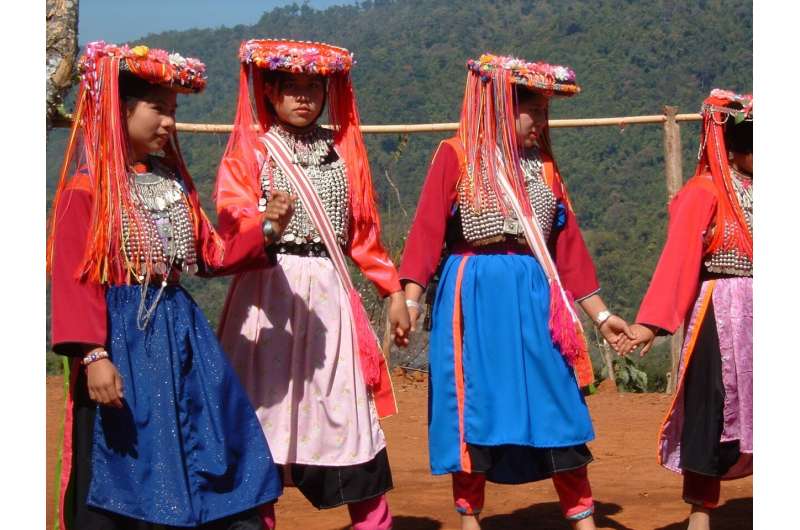This article has been reviewed according to Science X's editorial process and policies. Editors have highlighted the following attributes while ensuring the content's credibility:
fact-checked
peer-reviewed publication
trusted source
proofread
Extractive and industrial development projects threaten the future of Indigenous Peoples: Study

Extractive and industrial development projects threaten the fundamental rights of Indigenous Peoples, according to the results of an extensive scientific study carried out by the Institute of Environmental Science and Technology of the Universitat Autònoma de Barcelona (ICTA-UAB), which quantifies the negative impacts that these activities have on the lifeways, rights and lands of these communities.
The research, carried out in collaboration with nine other universities from around the world, demonstrates the violations of Indigenous rights through the largest quantitative analysis carried out to date at a global level. The study, published in the journal Science Advances, is based on data collected over the past decade by the Environmental Justice Atlas (EJAtlas), an initiative coordinated by ICTA-UAB that has identified and mapped a total of 3,081 socio-environmental conflicts around the world.
While Indigenous peoples comprise only 6.2% of the world's population and steward about a quarter of the world's land, they are directly affected by at least 34% of all documented environmental conflicts over extractive and industrial development projects. The study covers more than 740 different indigenous groups affected by such activities, representing at least 15% of the approximately 5,000 groups worldwide.
The Quechua, Mapuche, Gond, Aymara, Nahua, Ijaw, Munda, Kichwa, Guarani and Karen communities are the ten indigenous groups that appear most frequently featured in the EJAtlas dataset.
However, researchers believe that the actual number of affected Indigenous groups is expected to be much higher as "there are still significant data gaps, particularly in Central Asia, Russia and the Pacific, where data coverage is more limited," explains Arnim Scheidel, ICTA-UAB researcher and co-author of the study who highlights the great effort made by Indigenous and non-indigenous researchers and hundreds of collaborators who have collected relevant information for the EJAtlas since its creation.
Eight out of 10 environmental conflicts refer to only four sectors, with mining being the sector that most frequently impacts Indigenous Peoples (24.7%), ahead of the fossil fuel sector (20.8%), the agriculture, forestry, fishing and livestock sector (17.5%), and the construction and exploitation of hydraulic dams (15.2%).
According to the data collected, landscape loss (56% of cases), livelihood loss (52%) and land dispossession (50%) are reported to occur globally most often in conflictive development projects.
It is noteworthy that conflicts over projects liked to the agriculture, forestry, fisheries, and livestock sector show specifically high rates of reported impacts. Compared to other sectors and the global average, deforestation (74% of cases), land dispossession (74%), livelihood loss (69%), and biodiversity loss (69%) are reported to occur significantly more frequently in this sector.
"Land grabbing by agrobusiness and other extractive sectors continues to be a major threat to Indigenous Peoples," says Álvaro Fernández-Llamazares, ICTA-UAB scientist and co-author of the study. "That is why Indigenous communities all over the world have been mobilizing for decades to have their rights recognized and respected," he adds.
For the research team, the findings demonstrate the sheer size of indigenous rights' violations associated with industrial ways of life, and recall that international instruments like the International Labour Organisation's Convention C169 on indigenous peoples and the United Nations Declaration on the Rights of Indigenous Peoples play an important role for advancing indigenous rights. "However, current levels of ratification, implementation and monitoring are insufficient to ensure respect for such rights," they argue.
Therefore, they emphasize the need for governments to implement measures that further promote Indigenous rights and support environmental justice by ensuring real compliance with existing conventions and the protection of their land rights. "Governments should apply a zero-tolerance policy towards violations of indigenous rights and seek trade agreements that are conditional on compliance with the responsibilities of the UN Declaration by the companies involved."
With the aim of disseminating these results to society, the scientific team of this study has developed an informative video in collaboration with the University of Helsinki, Finland, which graphically shows the main conclusions of this study.
More information: Arnim Scheidel et al, Global impacts of extractive and industrial development projects on Indigenous peoples' lifeways, lands, and rights, Science Advances (2023). DOI: 10.1126/sciadv.ade9557. www.science.org/doi/10.1126/sciadv.ade9557
Journal information: Science Advances
Provided by Autonomous University of Barcelona




















